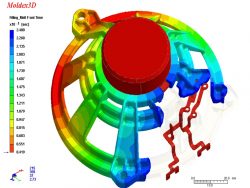How to maintain business growth during economic recession, when more and more companies and consumers are cutting down their expenses? 3D CAE software such as Moldex3D is the optimal solution for manufacturers. Enhanced visualization of design process allows greater innovation, as well as larger and faster productions. According to Aberdeen Group’s “Simulation Driven Design Benchmark Report” in October, 2006: all best-in-class manufacturers are using simulation technology in the design phase.
Is your CAE system keeping up with industry trends?
Jon Peddie Research, a technically oriented marketing, research, and management consulting firm, stated: “in 2007 the majority of CAD users (63%) are still working in 2D, while 37% work in 3D. However, revenues for 3D CAD surpassed 2D CAD taking 53% of the market.” This report indicates a healthy growth rate through 2012 (15% for the year 2008) for the 3D CAD software industry.
Why can 3D CAD software be so successful? Ved Narayan from The Economic Times wrote, “engineers working in a 3D design environment can eliminate lengthy error checking, make quick design changes, minimize reliance of physical prototyping, accelerate manufacturing cycle and improve support for documentation, publication and marketing processes.”
While 3D CAD software allows designers to create objects closer to their imagination, 3D CAE is a particularly advanced technology in that it provides far more precise simulation results for the industrial engineers. Better simulation results during pre-production stage helps to save significantly amount of time on trial and error. Another advantage of using 3D CAE software is that it supports 3D CAD model; while in the past, it requires hours or days (and training) to convert 3D model into shell-like 2.5D mesh before analyzing the data.

2.5D is outdated, but you still stand a chance
One might argue that traditional 2.5D simulation analysis is faster and more efficient. This statement, however, is becoming outdated. First of all, 2.5D analysis can only stay accurate when wall thickness is uniform and thin, which does not response to the diversity of today’s products. 3D analysis technology can overcome this problem by allowing users to perform simulations on thick and solid parts or those that have extreme wall-thickness changes from thin to thick. Secondly, new CPU technologies have delivered incredible breakthroughs in PC performance. The availability of 64-bit computer system, multi-core CPU, PC-Cluster, and etc. can make 3D analysis tasks be processed in no time! Therefore, 3D analysis is becoming the mainstream of CAE software technology, adopting 3D for core analysis is no doubt a “must” in 21st century!

To accelerate, and to stay accurate!
Some of the most important factors to compete during economic recession are to speed up the development cycle, save costs, and increase one’s production capacity. In other words, the time spent on research and development is crucial. Lee Iacocca, an American businessman commonly known for his revival of the Chrysler Corporation in the 1980s, had said: “If you want to make good use of your time, you’ve got to know what’s most important and then give it all you’ve got.” CAE simulation technology can save time by discovering design flaws and critical microscopic phenomena such as fountain flow, runner imbalance, 3D fiber orientation, etc.
To solve problems in advance is to shorten your time to market! For instance, if 95% potential problems of product/mold design can be solved within one day through high-performance CAE tool, the time to market can be reduced to 2 to 3 weeks earlier for mobile phone products that usually require 1 to 3 months to release, the profit margin of manufacturers will be increased dramatically to earn hundreds million dollars!